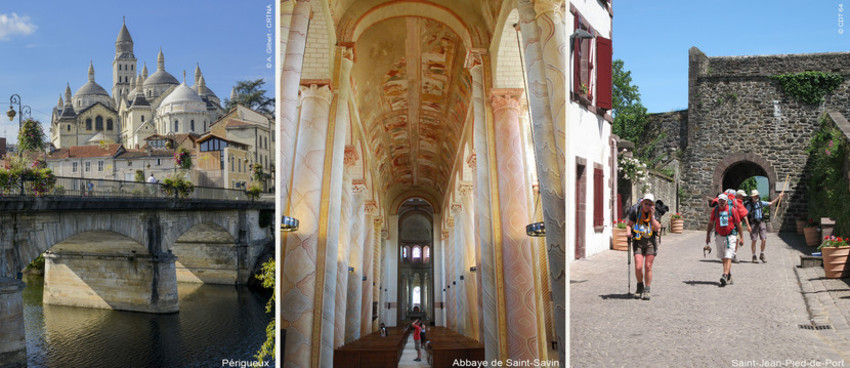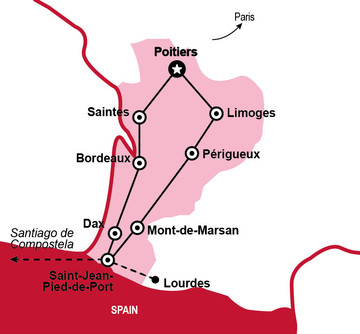- Ideas of tours
- On the way of Saint James
On the way of Saint James
5 days


Since the 9th-Century, Nouvelle-Aquitaine has been traversed by pilgrims on their way to Santiago de Compostela in Spain, on the most famous pilgrimage route in Europe. Six major Jacobean routes converge in the region, crossing preserved landscapes and historic monuments, 26 of which are classified as World Heritage Sites by UNESCO. On foot, by bike, on horseback, in a motorhome, you will meet believers but also the curious, art or sport lovers and friends of nature.
>> THE TOURS ROUTE
DAY 1 : Poitiers
City of a hundred bell towers, with its must-visit Notre-Dame-la-Grande, a masterpiece of Romanesque art; including the Saint-Hilaire church, listed as a UNESCO World Heritage Site Saint-Pierre cathedral, the Saint-Jean baptistery (dating from Merovingian times). Next to Poitiers, stopover at the Abbey of Saint-Savin, another UNESCO heritage site featuring the largest collection of mural paintings in Europe from the 11th and 12th-Centuries.
DAY 2 : Saintes
Visit Abbaye aux Dames, former Benedictine abbey created in 1047, the first women’s abbey in Saintonge. Today, music is at the heart of the abbey with a festival, and concerts. Then, head to Pons and its Pilgrims’ Hospital (on UNESCO World Heritage List).
DAY 3 : Bordeaux
A city with three Jacobean churches, registered on the UNESCO World Heritage List: the Basilica of Saint-Seurin, famous for its crypt containing 5th-Century remains, is a major place of antiquity; Saint-André Cathedral, the most beautiful religious
monument in Bordeaux; The Basilica of Saint-Michel and its imposing bell tower.
DAY 3 : Dax
The cathedral, in the classical “neo-Greek” style, was built between the middle of the 17th-Century and the end of the 19th-Century. Gallo-Roman walls, and hot a hotspring dating back to antiquity. Stopover to the Benedictine Abbey in Sordel’Abbaye
with three remarkable architectural features: the abbey church built at the end of the 11th-Century, the monastery buildings, and the villa of the Abbots.
DAY 4 : Saint-Jean-Pied-de-Port
The Notre-Dame church, built on the ramparts, has a 13th-Century foundation and is one of the most important Basque Gothic buildings. The Santiago Gate has UNESCO World Heritage status.
>> THE VEZELAY ROUTE
DAY 1 : Poitiers and the Abbey of Saint-Savin
DAY 2 : Limoges
Crypt of Saint-Martial, the crypt was located under the former Benedictine abbey of Saint-Martial, founded in the 11th-Century and was destroyed in 1792. It contains the last remains of the important necropolis where Saint-Martial was buried.
DAY 3 : Périgueux
Saint-Front Cathedral, classified as a UNESCO World Heritage Site. In Romano-Byzantine style, it recalls Saint Mark’s Basilica in Venice, and was built in the 12th-Century.
Mont-de-Marsan: Don’t forget to visit the Church of the Madeleine, followed by the “Notre-Dame-du-Rugby” chapel.
DAY 4 : Saint-Jean-Pied-de-Port
The Notre-Dame church, built on the ramparts, has a 13th-Century foundation and is one of the most important Basque Gothic buildings. The Santiago Gate has UNESCO World Heritage status.
Lourdes, one of the world’s most important places of Catholic pilgrimage, is also nearby.
DAY 5 : Santiago de Compostela
Place of arrival for the Way of Saint James to receive the compostela (kind of diploma proving that the pilgrimage has been carried out) and this is also where the Apostle Saint James lies buried.
In the same heading
- Rugby world cup 2023 : itineraries in Nouvelle-Aquitaine
-
Ideas of tours in Nouvelle-Aquitaine
- Touring from major european cities
- From Bordeaux vineyards to the French Riviera
- The Atlantic Coast : from Bilbao to Mont-St-Michel
- Southwestern culture
- The essentials of Nouvelle-Aquitaine
- Starting from Bordeaux
- Starting from Sarlat
- Starting from Biarritz
- Starting from La Rochelle
- Savoir-faire
- World-famous vineyards
- The secret vineyards
- On the road to the most beautiful villages in France
- On the way of Saint James
- In the heart of nature
- All in the saddle for an active holiday
- The Canal des 2 mers by bike or boat
- Unusual and playful
3 TOP ACCOMODATION PICKS
• Best western Le Grand Hotel 4* in Poitiers.
• Radisson Blu Hotel 4* in Bordeaux.
• Hôtel les Pyrénées 4* in Saint-Jean-Pied-de-Port.

Exceptional itineraries around and from Nouvelle-Aquitaine
An inspiring guide to “reference” tours. This SMARTguide aims to assist you in planning the very best itineraries around, and from our region.
>> Download the smartguide itineraries in english.
>> Download the smartguide itineraries in french.
>> Download the smartguide itineraries in german.
>> Download the smartguide itineraries in chinese.
